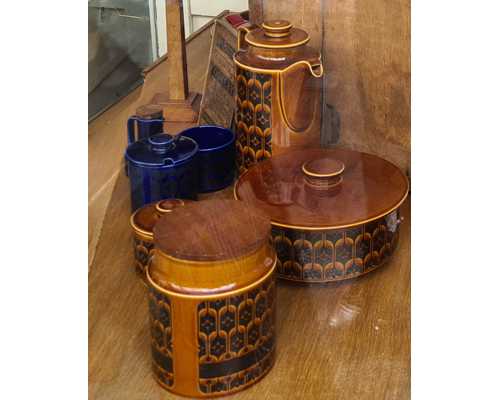
They're also popular in cafés and antique shops.
The reason I notice them is that they were manufactured by Hornsea Pottery in my home town. Hornsea Pottery was the largest employer in the town (despite the claims by one of my teachers that the secondary school was) and it produced a large range of striking designs. The ones in this particular coffee shop window (snapped in Canterbury earlier this year) are the Heirloom range. They, and another two ranges (Saffron and Brontë), are the ones I see the most often; they're reminiscent of the particular bygone era that coffee shops seem to want to recapture.
Hornsea Pottery went into receivership in 1984, a victim of the 1980s recession, over-zealous oversight by the NatWest bank and an obstructive local council that wouldn't let it expand its site so it had to open a second factory in Lancaster. The company was successfully taken over, but finally closed down in 2000. The fact that there are so many of its pieces of tableware still around may have been a factor: they didn't easily break (although I always thought the teapot spouts were prone to chipping) and continued to look good, so people didn't need to buy more.
The designs were sold off and are now owned by a holding company that doesn't seem to do a lot with them. Weirdly, the name of my home town, Hornsea, is a trade mark owned by this company; it's currently in the process of being renewed so that Hornsea® applies not only to the original "pottery; beverage glassware; glassware" category, but also to costume jewellery, furniture, decorative wall plaques, textiles, household textile goods, clothing, wallpapers, tea beverages, beer, other alcoholic beverages and interior design. Whether this is because Hornsea Pottery Intellectual Property Ltd has ambitions to move into these areas or merely hopes to sell its designs to companies that do isn't clear. Anyone hoping to set up a micro-brewery to make Hornsea beer would perhaps be surprised to learn that they can't use the name because the pottery people have that covered, anyway.
Over two hundred pieces of Hornsea Pottery are in the permanent collection of the Victoria & Albert museum. I don't know if they're on display, but around half of of them can be found on the V&A's web site.
Somewhat ironically, almost all of the items of Hornsea pottery sold in Hornsea itself were seconds. These did not tend to like the attention of dishwashers, and invisible cracks gradually became alarmingly visible. It's for this reason that we don't have much of it left in our house except for a few mid-sized plates we don't often use.
It's a shame, because growing up drinking out of Hornsea Pottery mugs means I want all my mugs to hold the exact same amount of liquid as Hornsea Pottery mugs did, otherwise they seem just Wrong.